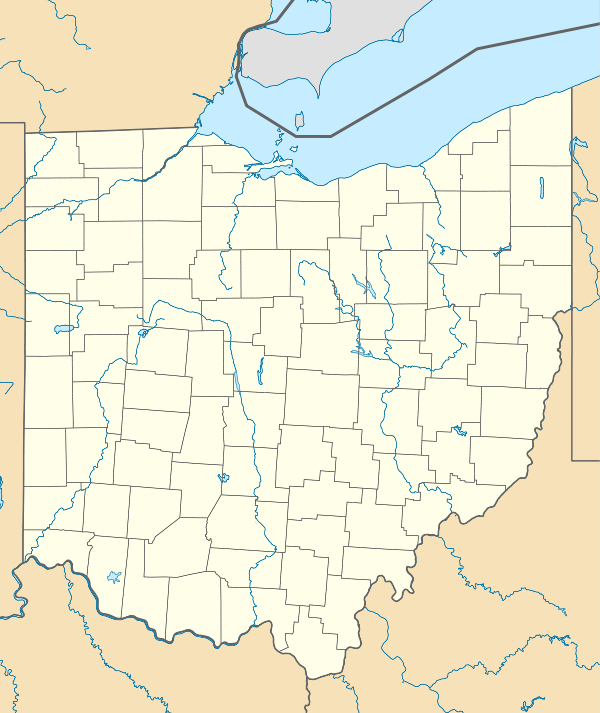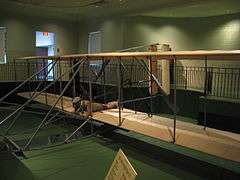Wright Flyer III
| Wright Flyer III | |
|---|---|
.jpg) | |
| The Wright Flyer III over Huffman Prairie, October 4, 1905 during its 46th flight | |
| Role | Experimental airplane |
| National origin | United States |
| Designer | Orville and Wilbur Wright |
| First flight | June 23, 1905 |
| Number built | 1 |
| Developed from | Wright Flyer II |
| Career | |
| Preserved at | Dayton Aviation Heritage National Historical Park |
The Wright Flyer III was the third powered aircraft by the Wright Brothers, built during the winter of 1904-05. Orville Wright made the first flight with it on June 23, 1905. The Flyer III had an airframe of spruce construction with a wing camber of 1-in-20 as used in 1903, rather than the less effective 1-in-25 used in 1904. The new machine was equipped with the engine and other hardware from the scrapped Flyer II and—after major modifications—achieved much greater performance than Flyers I and II.
Design and development
As initially built, the Flyer III looked almost the same as its predecessors and offered equally marginal performance. Orville suffered minor injuries in a serious nose-dive crash in the machine on July 14, 1905. When rebuilding the airplane, the Wrights made important design changes that solved the stability problems of the earlier models.[1] They almost doubled the size of the elevator and rudder and moved them about twice the distance from the wings. They added two fixed half-moon shaped vertical vanes (called "blinkers") between the elevators (but later removed) and widened the skid-undercarriage which helped give the wings a very slight dihedral. They disconnected the rudder of the rebuilt Flyer III from the wing-warping control, and as in most future aircraft, placed it on a separate control handle. They also installed a larger fuel tank and mounted two radiators on front and back struts for extra coolant to the engine for the anticipated lengthy duration flights. When testing of Flyer III resumed in September, improvement was obvious. The pitch instability that had hampered Flyers I and II was brought under control. Crashes, some of which had been severe, no longer occurred. Flights with the redesigned aircraft started lasting over 20 minutes. The Flyer III became practical and dependable, flying reliably for significant durations and bringing its pilot back to the starting point safely and landing without damage.
On October 5, 1905 Wilbur made a circling flight of 24 miles (38.9 km) in 39 minutes 23 seconds,[2] over Huffman Prairie, longer than the total duration of all the flights of 1903 and 1904. Four days later, they wrote to the United States Secretary of War William Howard Taft, offering to sell the world's first practical fixed-wing aircraft.
Flying at Kill Devil Hills

To keep their knowledge from falling into competitors' hands, the Wrights stopped flying and disassembled the airplane on November 7, 1905.[3] Two and a half years later, having won American and French contracts to sell their airplane, they refurbished the Flyer with seats for a pilot and passenger, equipped it with upright control levers and installed one of their new 35-horsepower in-line vertical engines. They shipped it to North Carolina and made practice flights near Kill Devil Hills from May 6 to 14, 1908 to test the new controls and the Flyer's passenger-carrying abilities.
On May 14, 1908, Wilbur flew mechanic Charles Furnas (1880–1941) 1,968 feet (600 m) in 29 seconds, making him the first airplane passenger.[4][5] The same day, Orville also flew with Furnas, this time 2,125 feet (648 m) in 4 minutes 2 seconds. Orville's flight with Furnas was seen by newspaper reporters hiding among the sand dunes; they mistakenly thought Wilbur and Orville were flying together. He is one of the few people to fly with both Wright brothers (their sister Katharine being another).
Later that day, Wilbur was flying solo when he moved one of the new control levers the wrong way and crashed into the sand, suffering bruises. The Flyer's front elevator was wrecked and the practice flights ended. Due to deadlines for their upcoming public demonstration flights in France and Virginia, the Wrights did not repair the airplane and it never flew again.
Survivors
The Wright Flyer III was left in its damaged condition in the North Carolina hangar. In 1911 the Berkshire Museum of Pittsfield, Massachusetts, through one Zenas Crane, obtained most of the components from both the abandoned Flyer and the 1911 Wright glider, but never assembled or exhibited them. The parts of the 1905 aircraft remained in Massachusetts for almost forty years, until Orville requested their return in 1946 for the Flyer's restoration as a central exhibit at Edward A. Deeds' Carillon Park in Dayton, Ohio. Some Kitty Hawk residents also possessed pieces of the 1905 airplane; Deeds and Orville also obtained many of these for the restoration. At the end of the 1947–1950 restoration process, craftsmen estimated that the 1905 aircraft retained between 60 and 85% of its original material. The 1905 airplane is now displayed in the Wright Brothers Aviation Center at Carillon Historical Park. The aircraft and display are part of the Dayton Aviation Heritage National Historical Park. The restored 1905 Wright Flyer III is the only fixed-wing aircraft to be designated a National Historic Landmark.
Found artifact

A historic missing piece of the Flyer III, thought to be a piece of Flyer I, turned up in 2010 in the hands of Palmer Wood, whose uncle, Thomas, had given him the piece in the 1960s. Wood took the piece to Brian Coughlin, an aircraft collector, who, not knowing what the piece was, took it to Peter Jakab of the Smithsonian Institution. The missing piece is the actuator, which connects the moment chain or arm (the Wrights still used chain link in 1905) to the front elevator. In the 1940s Orville gathered all of the stray pieces of the Flyer that were not in Massachusetts from Kitty Hawk locals who, as children, raided the Wrights' 1908 hangar for souvenirs. The actuator piece, which more than likely broke away in Wilbur's sand dune crash of May 14, 1908, somehow missed Orville's gathering efforts and was replaced with a solid or flanged piece which the Wrights did not start using until 1908. According to Peter Jakab the flanged piece is not accurate to the 1905 configuration of the Flyer III. The Wrights in 1905 used a wood assembly joined together by small flat plates and screws. The solid flat piece now on the Flyer was substituted in the 1947–50 restoration for the missing actuator.[6]
Specifications (Flyer III)
|
Wright Flyer III | |
|
Flyer III in the museum | |
  | |
| Location | Dayton, Ohio |
|---|---|
| Coordinates | 39°43′40″N 84°12′7″W / 39.72778°N 84.20194°WCoordinates: 39°43′40″N 84°12′7″W / 39.72778°N 84.20194°W |
| Built | 1905 |
| Architect | Wright, Orville; Wright, Wilbur |
| Architectural style | Other |
| NRHP Reference # | 90001747[7] |
| Added to NRHP | June 21, 1990 |

Data from Sharpe, 2000. p 311.
General characteristics
- Crew: one pilot
- Length: 28 ft 0 in (8.54 m)
- Wingspan: 40 ft 4 in (12.29 m)
- Height: 8 ft 0 in (2.44 m)
- Wing area: 503 ft² (46.8 m²)
- Loaded weight: 710 lb (323 kg)
- Max. takeoff weight: 710 lb (323 kg)
- Powerplant: 1 × Wrights' water-cooled, 4-cylinder, inline engine, 20 hp (15 kW)
- Propellers: Wrights' elliptical propellers later changed to Wrights' "bent-end" propellers propeller, 2 per engine
Performance
- Maximum speed: 35 mph (56 km/h)
- Range: 25 miles (40 km) as of October 1905
- Service ceiling: 50 to 100 ft (15 to 30 m)
- Wing loading: 1.4 lb/ft² (7 kg/m²)
- Power/mass: 0.03 hp/lb (0.05 kW/kg)
See also
- Related development
References
- Notes
- ↑ Gorman, James (January 15, 2014). "With Math as Inspiration, a New Form of Flyer". The New York Times. Retrieved 20 January 2014.
- ↑ Sharpe, Michael (2000). Biplanes, Triplanes and Seaplanes. Friedman/Fairfax. p. 311. ISBN 1-58663-300-7.
- ↑ "1905 - The First Practical Airplane, U.S. Centennial of Flight Commission, Retrieved on 2010-06-05.
- ↑ "This Month in Exploration - May: 100 Years Ago". NASA. Retrieved August 29, 2012.
- ↑ Tom D. Crouch (August 29, 2008). "1908: The Year the Airplane Went Public". Air & Space/Smithsonian. Retrieved August 29, 2012.
- ↑ Air & Space Magazine, Smithsonian Institution issue January 2011 page 13 article title The Wrong Wright Part by Patricia Trenner
- ↑ National Park Service (2007-01-23). "National Register Information System". National Register of Historic Places. National Park Service.
- Bibliography
- Sharpe, Michael (2000). Biplanes, Triplanes, and Seaplanes. London: Friedman/Fairfax Books. ISBN 1-58663-300-7.
External links
| Wikimedia Commons has media related to Wright Flyer III. |
- Dayton Aviation Heritage National Historical Park
- Information on mechanic Charles Furnas
- Modern flying replica of Wright Flyer III
- Rescue and preservation of Wright Flyer III by Jeanne Palermo
- Wright Brothers Flight Logs
